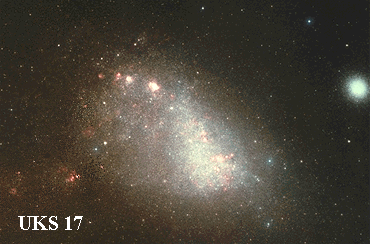Image Credit & Copyright: Anglo-Australian Telescope Board Explanation: Almost unknown to casual observers in the northern hemisphere, the southern sky contains two diffuse wonders known as the Magellanic Clouds. The Magellanic Clouds are small irregular galaxies orbiting our own larger Milky Way spiral galaxy. The Small Magellanic Cloud (SMC), pictured here, is about 250,000 light years away and contains a preponderance of young, hot, blue stars indicating it has undergone a recent period of star formation. There is evidence that the SMC is actually two galaxies superposed to appear as one. The bright blob near the right hand edge of the frame is a globular cluster near the outskirts of the Milky Way. Tomorrow's picture: GL 105C: The Coolest Star? | Archive | Glossary | Education | About APOD | Astronomy Picture of the Day (APOD) is created and edited in 1995 by Robert Nemiroff (GMU) and Jerry Bonnell (USRA). Specific rights may apply. Correspondence about APOD should be addressed to nemiroff@grossc.gsfc.nasa.gov or bonnell@grossc.gsfc.nasa.gov. A service of the Laboratory for High Energy Astrophysics (LHEA) at NASA/ GSFC Technical Rep: Sherri Calvo, 301-286-5668, sherri.calvo@gsfc.nasa.gov Questions/Comments/Feedback to: feedback@athena.gsfc.nasa.gov General astronomy pointers are available.
1995-09-19
The Small Cloud of Magellan
Almost unknown to casual observers in the northern hemisphere, the southern sky contains two diffuse wonders known as the Magellanic Clouds. The Magellanic Clouds are small irregular galaxies orbiting our own larger Milky Way spiral galaxy. The Small Magellanic Cloud (SMC), pictured here, is about 250,000 light years away and contains a preponderance of young, hot, blue stars indicating it has undergone a recent period of star formation. There is evidence that the SMC is actually two galaxies superposed to appear as one. The bright blob near the right hand edge of the frame is a globular cluster near the outskirts of the Milky Way.
